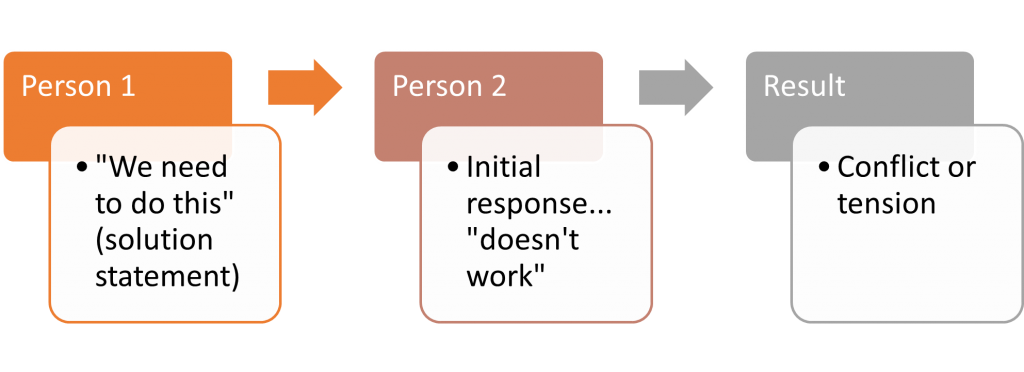Potential conflicts can arise when solutions are communicated instead of discussing desired outcomes. Consider the following situation:
Parent board member: “I want all coaches to stay at the training facilities for half an hour after every training to be available to talk to parents”
Coach: “We can’t do that – we are already working more hours than we have time for, plus we have families at home”
Such a situation could easily create conflict between coach and parent board member. And yet behind the parent’s proposal lies an important idea – the snag is that the underlying idea has not been communicated by the parent, rather only one possible solution has been proposed as the only solution (the “solution statement”), that may or may not be achievable.
Disagreements and conflicts can start when people begin by stating their “solution statement”. If the solution doesn’t “work” then conflict could follow.

A leader or skilled communicator, however, will hear the “solution statement” as simply an introductory dialogue into a more interesting conversation about what outcome is sought.

If the focus of the discussion could be brought to what the desired outcome is, a lot of pain and uncomfortable disagreements could be avoided. Thus, in the above example, the coach could respond by exploring the reasons behind the parent board member’s proposal, namely a desire for improved communication between coach and all parents. When the desired outcome is understood, true discussions and brain storming can take place in a spirit of fellowship rather than antagonism.
Choosing a restaurant
We can take a second example to illustrate how communication can create conflict even though that is not the intention. For example, imagine the following scenario where a family is deciding where to go out to eat.
- Parent 1: Which restaurant are we going to?
- Child 1: What about St. Elmo’s
- Parent 2: I was thinking Noma
- Child 1: Road House is also good
- Parent 1: How about eating at Rocco’s
- Parent 2: Yes, but we could also go to Noma
This conversation could go on for a long time, with everybody becoming frustrated. The common theme in the comments made by the family members is:
- they each say what they want
- their replies are orientated on the process of going to somewhere, rather than why they made that choice in the first place
By continually focussing on what they want themselves, they forgot to seek to understand why the other family members want something different. Equally, the first question encourages frustration. Better would be to ask questions that seek to gain understanding of the outcome, for example:
What kind of food would you like to eat?
What kind of dining experience are we looking for?
Maybe Child 1 wants ribs and have sports playing on large screens, Parent 1 is thinking steaks, whilst Parent 2 wants a fine dining experience. None of these outcome desires are wrong, but by understanding the desired outcome of each person, it would then be possible to find a solution that works for everyone or agree through open dialogue that one of the restaurant experiences would have to wait until another time.
In sporting and business environments, the same conflict occurs whereby the primary focus of dialogue is on the process/solution rather than first gaining a shared understanding of the ultimate outcome.
As a professional leader, you can choose to use your skills to guide the conversation into shared understanding of the ultimate outcomes (the reasons behind the proposed solution that you are met with).
How to respond
An athlete comes to the coach with the following message: “the junior members of the team need their own training sessions – we can’t improve when we train together with the seniors”.
The initial thoughts and reactions of the coach could be many: we don’t have space to separate the seniors and juniors; I disagree that the juniors can’t improve; the athlete doesn’t think I am doing a good enough job; and so on.
The coach, however, needs to take some deep breaths, and start by showing compassion and gratitude to the athlete. How? By listening and by asking questions to gain understanding of what is being said.
Why gratitude? Because coaches should be thankful when athletes speak up and communicate and look to take on shared responsibility for their training environment.
Be curious rather than letting your own ego take over. Your own ego may feel like it is being attacked, but it isn’t. Your athlete is probably not communicating in the clearest way (they start with a solution rather than explaining the problem or by sharing their concerns).
Remember that those you work with (athlete, parent, board member) are not necessarily communications specialists – but you can be! Start with compassion when faced with a potential clash or differing of opinions. The person talking to you has their own concerns and whilst their solution or method of communicating may not be optimal; there exists a need that should be understood and then addressed.
In summary
When faced with a solution statement, choose to experience it as an important introductory comment, that needs exploring. Be curious, ask questions and gain understanding so that you can help find an effective solution in cooperation with the other person.

